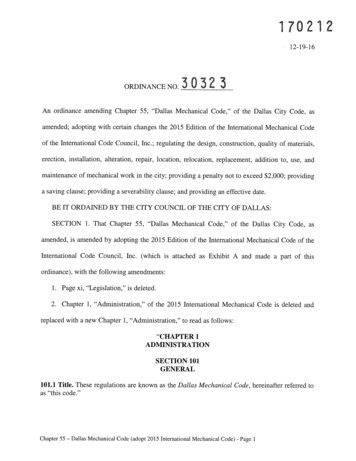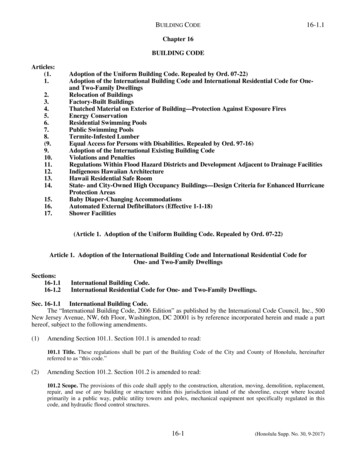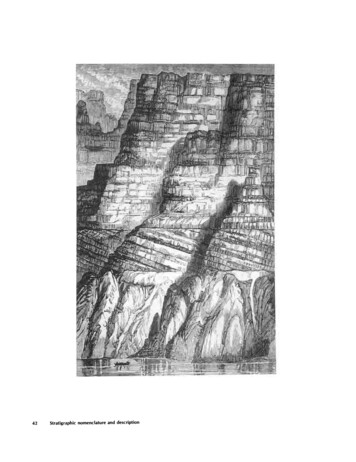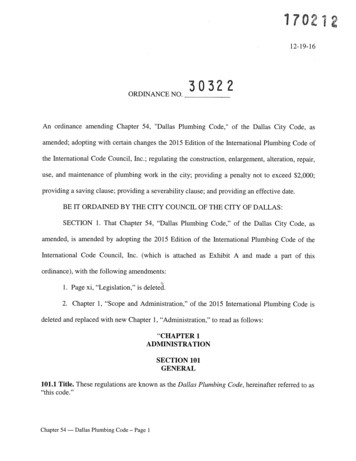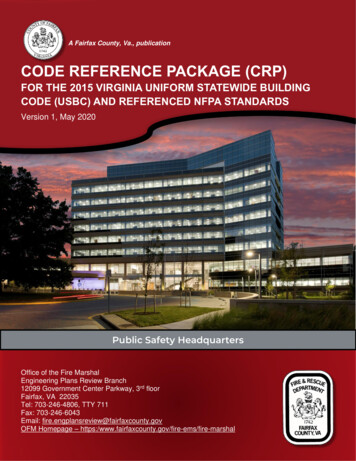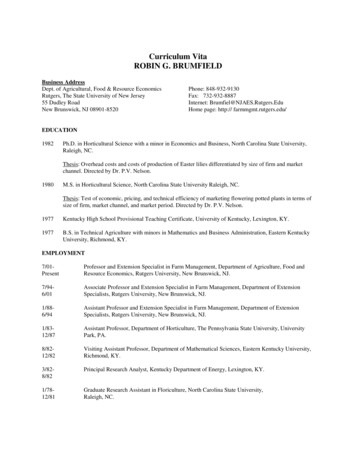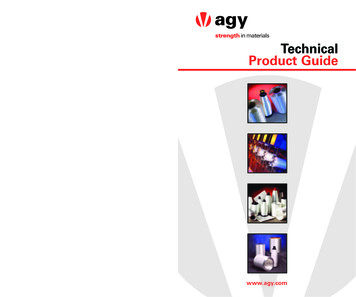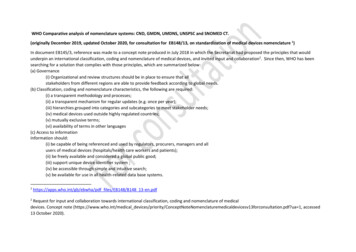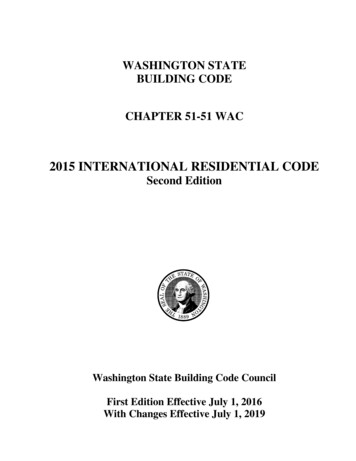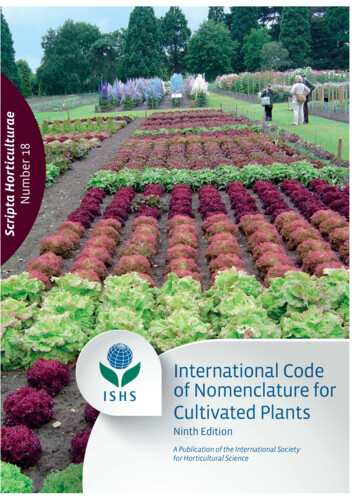
Transcription
INTERNATIONAL CODE OF NOMENCLATUREFOR CULTIVATED PLANTS(ICNCP or Cultivated Plant Code)incorporating the Rules and Recommendationsfor naming plants in cultivationNinth EditionAdopted by the International Union of Biological SciencesInternational Commission for the Nomenclature of Cultivated PlantsPrepared and edited byC.D. Brickell (Commission Chairman), C. Alexander, J.J. Cubey, J.C. David,M.H.A. Hoffman, A.C. Leslie, V. Malécot, Xiaobai Jin,members of the Editorial CommitteeJune, 2016
ISSN 1813-9205ISBN 978-94-6261-116-0, Scripta Horticulturae Number 18Published by ISHS, June 2016Executive Director of ISHS: Ir. J. Van AsscheISHS Secretariat, PO Box 500, 3001 Leuven 1, BelgiumPrinted by Drukkerij Station Drukwerk, PO Box 3099, 2220 CB Katwijk aan Zee, The Netherlands 2016 by the International Society for Horticultural Science (ISHS). All rights reserved. No part ofthis book may be reproduced and/or published in any form or by any means, electronic or mechanical,including photocopying, microfilm and recording, or by any information storage and retrieval system,without written permission from the publishers.Photograph on the front cover:Lettuce trial 2003. Credit: RHS / Jacquie Gray.
ContentsCONTENTSForewordMembership of the IUBS International Commission for the Nomenclature of CultivatedPlantsPrefaceComparison between the 2009 Code and this editionNew provisionsImportant dates in this CodePrevious editions of this CodePREAMBLEDIVISION I: PRINCIPLESDIVISION II: RULES AND RECOMMENDATIONSChapter I: General provisionsArticle 1: Relationship with the International Code of Nomenclature for algae,fungi, and plantsChapter II: DefinitionsArticle 2: The cultivarArticle 3: The GroupArticle 4: The grexArticle 5: The chimaeraArticle 6: The denomination classArticle 7: PublicationArticle 8: Names and epithetsArticle 9: Date of a nameArticle 10: Established namesArticle 11: Accepted namesArticle 12: Conserved namesArticle 13: Trade designationsChapter III: Conventions for presentation of namesArticle 14: Cultivar statusArticle 15: Group statusArticle 16: Grex statusArticle 17: Trade designation statusChapter IV: Limitation to the principle of priorityArticle 18: Starting points in nomenclatureArticle 19: Conservation of namesChapter V: Naming plants in cultivationArticle 20: Names of wild plants brought into cultivationInternational Code of Nomenclature for Cultivated Plants – Ninth 181819191920202222222323iii
ContentsArticle 21: Names of cultivarsArticle 22: Names of GroupsArticle 23: Names of grexesArticle 24: Names of graft-chimaerasChapter VI: Publication and establishmentArticle 25: Conditions of publicationArticle 26: Date of publicationArticle 27: Conditions of establishmentArticle 28: Citation of authors’ namesChapter VII: Choice, re-use, and rejection of namesArticle 29: Choice of namesArticle 30: Re-use of epithetsArticle 31: Rejection of namesChapter VIII: Translation, transliteration, and transcriptionArticle 32: Translation of epithetsArticle 33: Transliteration of epithetsArticle 34: Transcription of epithetsChapter IX: Spelling (orthography)Article 35: Spelling of epithetsDIVISION III: NAMES OF HYBRID GENERADIVISION IV: REGISTRATION OF NAMESDIVISION V: NOMENCLATURAL STANDARDSDIVISION VI: MODIFICATION OF THIS CODEAppendix I: Directory of International Cultivar Registration AuthoritiesAppendix II: Directory of statutory plant registration authoritiesAppendix III: Places maintaining nomenclatural standardsAppendix IV: Libraries holding significant collections of nursery cataloguesAppendix V: Special denomination classesAppendix VI: List of conserved and rejected epithetsAppendix VII: Latin names of plantsAppendix VIII: The nomenclatural filterAppendix IX: Quick guide for new cultivar namesAppendix X: Plant designations not governed by the ICNCPAppendix XI: Flow chart of nomenclatural bodies and processesGlossaryIndex of scientific namesSubject tional Code of Nomenclature for Cultivated Plants – Ninth Edition
ForewordFOREWORDThis ninth edition of the International Code for the Nomenclature for Cultivated Plantsreplaces the eighth edition of the Code which was published in October 2009 as ScriptaHorticulturae Number 10 and as Regnum Vegetabile Vol. 151.This new edition derives from decisions taken at a meeting of the IUBS InternationalCommission for the Nomenclature of Cultivated Plants held over 20–21 July 2013 inBeijing, China. Prior to this meeting requests for suggestions to amend the previousCode had been sought from all interested parties and some of these proposals werepublished in Hanburyana (Vol. 5, 2011, Vol. 6, 2012 and Vol.7, 2013). All theproposals that had been submitted were collated by Janet Cubey and forwarded to theCommission Members in advance of the meeting, so that those not able to attend couldmake their opinions known. Copies of the proposals were also circulated to all thoseattending the Sixth International Symposium on the Taxonomy of Cultivated Plants,which had been held on 15–19 July in Beijing, immediately prior to the Commissionmeeting. An open discussion on the proposals was held on the final day of theSymposium.At the Commission meeting all the proposals to amend the Code were discussed andwhere appropriate were voted on by those present. The views of those members unableto attend, as well as opinions expressed by those attending the Symposium, wereconveyed to the meeting. At the meeting in Beijing we also benefited from theattendance of three observers whose invited contributions were much appreciated.These were: Yolanda Herta (UPOV, Switzerland), Jean Maison (CPVO, France) andNatalie Iwanycki (Royal Botanical Gardens, Canada). At the conclusion of the meetingan Editorial Committee was appointed to carry out the editing of the Code and toarrange for its publication. The Editorial Committee consisted of Chris Brickell(Chairman), Crinan Alexander, John David, Marco Hoffman, Alan Leslie, ValéryMalécot and Xiaobai Jin, with Janet Cubey as Editorial Committee Secretary.The Commission is very grateful to the Beijing Forestry University and the convenersof the Symposium, Qixiang Zhang and Xiaobai Jin, for providing facilities andhospitality for the Commission meeting.Initial work on preparing the new edition was carried out at Wisley by Janet Cubey,John David, Alan Leslie and myself, using transcribed recordings taken at the meeting,as well as the notes taken by the Editorial Committee Secretary. Drafts were forwardedto other members of the Editorial Committee and following further discussion anddebate a final version (together with a request for an additional vote on the provisionsof Art. 34) was circulated to the full Commission membership for further commentsand suggestions prior to publication. I would like to thank Xiaobai Jin in particular forInternational Code of Nomenclature for Cultivated Plants – Ninth Editionv
Forewordhis meticulous attention to detail, which has been extremely helpful during the editorialprocess.The Commission is indebted to the following individuals who submitted proposals andsuggestions for the revision of this Code:James Armitage (UK), Saskia Bodegom (Netherlands), Roger Cross (Australia), JanetCubey (UK), Dawn Edwards (UK), Hiroyuki Iketani (Japan), Alan Leslie (UK), JohnMcNeill (UK), Charles Nelson (UK), Richard Sanford (UK), Johan van Scheepen(Netherlands), Julian Shaw (UK), Roger Spencer (Australia), Xiaobai Jin (China),Adrian Young (UK).I would like to express my gratitude to all these individuals, as well to those who tookpart in the Beijing Symposium discussions or have subsequently assisted us inpreparing this new edition of the Code. Richard Sanford (RHS, Wisley) in particularhas played a significant role in the preparation of this Code, notably in the preparationof both the Appendices and the Indexes. Janet Cubey and John David have bothcontributed significantly to ensuring the administration of the long editorial processwas conducted efficiently and I am grateful to them for their efforts.Since the last edition of the Code we have welcomed two new members: Dr MarcoHoffman, who joins us as the new Commission Secretary, and Janet Cubey, both ofwhom have already demonstrated their value to the Commission. Two members havestood down from the membership: Dr Wilbert Hetterscheid (our former Secretary) andDr Niall Green. I am most grateful to them all for their contributions to theCommission.This will be my last foreword as Chairman of the Commission and I would like toexpress my gratitude and warmest thanks to all the members of the Commission withwhom I have worked over the years both in the preparation of the Code and promotingits application to cultivated plants worldwide.Proposals to modify this Code will, when possible, be published in Hanburyana andincluded on the HORTAX website. They should be sent to The Chairman, TheEditorial Committee, ICNCP, c/o RHS Garden Wisley, Woking, Surrey GU23 6QB,UK or by email to icncp@rhs.org.uk.Chris Brickell, Chairman, IUBS International Commission for the Nomenclature ofCultivated Plants and Chairman, Editorial Committee, ICNCP.viInternational Code of Nomenclature for Cultivated Plants – Ninth Edition
CommissionIUBS INTERNATIONAL COMMISSION FOR THENOMENCLATURE OF CULTIVATED PLANTSMembers, July 2013ChairmanMr C.D. BrickellThe Camber, The StreetNutbourne, PulboroughWest Sussex RH20 2HEUnited KingdomSecretaryDr M.H.A. HoffmanApplied Plant Research, WageningenPO Box 85, 2160AB LisseThe NetherlandsBjörn AldénGothenburg botanical gardenCarl Skottsbergs gata 22ASE-41319 GothenburgSwedenDr Crinan AlexanderRoyal Botanic Garden Edinburgh20A Inverleith RowEdinburgh EH3 5LRUnited KingdomDr B.R. BaumAgriculture & Agri-Food Canada960 Carling AvenueOttawa, OntarioCanada K1A 0C6Dr Janet J. CubeyRHS Garden WisleyWokingSurrey GU23 6QBUnited KingdomDr J.C. DavidRHS Garden WisleyWokingSurrey GU23 6QBUnited KingdomIng. C. (Kees) van EttekovenNaktuinbouw, Sotaweg 222371 GD RoelofarendsveenThe NetherlandsDr Hugh F. GlenBox 1781, Forest HillsDurban, 3624 South AfricaDr Hiroyuki IketaniNational Institute of Fruit Tree SciencesNARO2-1 Fujimoto, Tsukuba305-8605 JapanDr A.C. Leslie109 York StreetCambridge CB1 2PZUnited KingdomDr Valéry MalécotInstitut de Recherches en Horticulture etSemences & Département ÉcologieAgrocampus-Ouest Centre d’AngersInstitut National d’Horticulture et de Paysage2 rue André Le Nôtre49045 Angers Cedex 01FranceProf. J. McNeill(appointed by IAPT for IUBS)Royal Botanic Garden Edinburgh20A Inverleith RowEdinburgh EH3 5LRUnited KingdomInternational Code of Nomenclature for Cultivated Plants – Ninth Editionvii
CommissionProf. Xiang QibaiNanjing Forestry UniversityLonpan Road 159Nanjing 210037, JiangsuChinaDr Roger SpencerRoyal Botanic GardensSouth Yarra, Victoria 3141AustraliaFreek VrugtmanRoyal Botanical GardensPO Box 399Hamilton, OntarioL8N 3H8CanadaviiiDr John H. WiersemaUS Department of Agriculture/AgriculturalResearch ServiceNational Germplasm Resources LaboratoryBldg 003, Beltsville Agricultural ResearchCenterBeltsville, Maryland 20705-2350United States of AmericaDr Jin XiaobaiInstitute of BotanyChinese Academy of Sciences20 Nanxincun, XiangshanBeijing 100093ChinaInternational Code of Nomenclature for Cultivated Plants – Ninth Edition
PrefacePREFACEThis ninth edition of this Code maintains the overall format and style of the eighth(2009) edition and whilst the general order of the Articles remains the same, somealteration to numbering within the Articles has been made to take into account theaddition or removal of some provisions. A comparative key listing changes innumbering within the Rules, Notes, Recommendations and Divisions between the2009 edition and the current edition is provided on page xii.A comparative list of new provisions appearing in Divisions II–VI is also provided toindicate differences between the 2009 Code and this edition (page xv).Whilst this Code is written in English, the Commission hopes that translations will bemade available in other languages and scripts so that it may be more widely used inthe naming of cultivated plants throughout the world. The Commission has continuedto pay particular attention to differing linguistic customs, taking into account wherepossible the formation and use of words and terms in different parts of the world.The Preamble outlines the justification for the publication of this Code and describesthe way in which the various provisions operate. It will be noted that the Rules andRecommendations of this Code are also intended to apply to all organisms traditionallytreated as plants, including all algae and fungi.The Principles are essentially the same as in the 2009 Code. There are two changes.The first reflects the renaming of the former International Code of BotanicalNomenclature as the International Code of Nomenclature for algae, fungi and plants,whilst the second acknowledges the use of trade designations, although making it clearthese are not regulated by this Code.The following changes and amendments relating to the Rules and Recommendationsfor the categories cultivar, Group and grex have been introduced in this edition of theCode:Exceptionally it will be permitted to publish the name for a new cultivar before theoriginal individual has been propagated (Art. 2.3 Note 5).Where a collective name has been given to a plant composed of different cultivars ona single rootstock, that name is to be treated as a trade designation (Art. 2.22 Note 7).A distinction is made between graft-chimaeras and mutation-chimaeras (Art. 5.1 and5.2).A name which has to be adopted following its use in a grant from a statutory plantregistration authority, and which replaces an earlier accepted name, is to be referred toInternational Code of Nomenclature for Cultivated Plants – Ninth Editionix
Prefaceas the adopted name. The earlier accepted name becomes a synonym of the adoptedname (Art. 11.3).It is noted that rules employed by statutory registration authorities in considering theacceptability of epithets (or ‘denominations’) may differ from those in this Code (Art.11.3 Note 1).Further guidance is provided to make it clear that code form epithets are acceptablewhen they differ by only one character or numeral (Art. 21.25).It is recommended that an epithet established in a non-Roman script should consist ofno more than 30 characters when transliterated or transcribed (Rec. 21K).It is recommended that epithets should not contain the epithet of a species from thegenus in which the cultivar, Group or grex belongs (Rec. 21M).It is recommended that where the original application of a cultivar epithet can nolonger be ascertained, different lineages may be distinguished by appending a devicesuch as the name of the originator of that lineage (Rec. 21N).It is recommended that Series may be treated as Groups where appropriate, and whereit does not cause confusion (Rec. 22B).Publications relating to an ICRA Register or Checklist which have appeared only inelectronic media, can be made nomenclaturally effective by the printing and depositof two copies in a designated library (Rec. 25C).The provision to permit the date of a published, but undated, trade catalogue to beestablished by subsequent research is extended to any publication (Art. 26.3).It is recommended that when an epithet is derived from a different language to that ofits publication the original word or phrase should be given at the time of establishment(Rec. 27D.3).The decision taken by an ICRA in choosing between competing names for the sameplant must be fixed by publication of that decision (Art. 29.2).The translation of an epithet, and the treatment of that translation as a tradedesignation, is to be avoided if the translation replicates an existing epithet in thedenomination class (Art. 32.1 Note 1).It is noted that where different authors have used separate transcription systems,transcribed epithets may not be identical, even when based on the same original epithet(Rec. 34A.1).It is recommended that reverse transcription should return words to their original form,irrespective of the demands of the transcription system used (Rec. 34A.2).xInternational Code of Nomenclature for Cultivated Plants – Ninth Edition
PrefaceIt is recommended that where a cultivar or grex name appears in a publication in alanguage that uses a non-alphabetic script different from that of its original publication,the original, or the Roman transcribed epithet, should be used whenever possible (Rec.34A.3).It is noted that this Code follows Kenkyusha’s New Japanese–English Dictionary inusing hyphens in transcribed epithets, contrary to the practice in the ALA-LCRomanization Tables (Rec. 34D.1 Note 2).Where duplicates of nomenclatural standards have been prepared, and are separatelyfiled, these may be referred to as duplicate standards (Div. V.1).It is noted that the names of graft-chimaeric genera are governed entirely by this Code.As they do not have types there are no type specimens or nomenclatural standards(Div. V.1 Note 2).In order to be effective the word standard (or a phrase such as nomenclatural standardor standard specimen) should be included in any statement where a standard isdesignated (Div. V Note 9).The way in which dates are described have, as far as possible, been made consistentthroughout the Code.There are no new Divisions or Appendices in this Code. However, the content of manyof these has been revised and edited to take account of recent changes. This affects inparticular Appendix I (Directory of International Registration Authorities), AppendixIII (Places maintaining nomenclatural standards), Appendix V (Special denominationclasses) and Appendix X which has been expanded to include not only guidance ontrade designations, but also advice on the handling of Series for cultivars.The Glossary has also been considerably revised and edited to ensure consistency andrelevance to the text of the Code.Whilst codes of nomenclature should remain bastions of stability for naming of plants,they do need to be updated in line with developing trends and practices that occur inthe disciplines they serve, as well as to reflect problems that have occurred in theoperation and interpretation of their rules. Whilst it is to be hoped that this edition willserve the users of cultivated plants for some years to come, the Commission alwayswelcomes further suggestions for its future development.C.D. Brickell. On behalf of the IUBS International Commission for the Nomenclatureof Cultivated Plants.October, 2015International Code of Nomenclature for Cultivated Plants – Ninth Editionxi
Codes, comparisonCOMPARISON BETWEEN THE 2009 CODE AND THIS EDITIONThis key demonstrates how the various numbered Rules, Notes, Recommendations,and Divisions of the 2009 edition of this Code may be compared with the provisionsof this edition. This does not necessarily indicate that the meanings or implications ofthe previous provisions remain unchanged.2009Div II1.11.21.31A.12.12.1 Nt.12.22.2 Nt.22.2 Nt.32.2 .162.172.182.192.19 Nt.5xii2016Div II1.11.31.41A.12.12.1 Nt.12.22.2 Nt.22.2 Nt.32.2 2.162.172.182.192.19 Nt.62.202.212.222.233.13.23.33.3 Nt.13.3 Nt.23.43.54.14.1 Nt.14.1 Nt.24.24.34.45.16.16.26.2 Nt.16.36.46.57.18.18.1 Nt. 18.1 Nt.28.28.32.202.212.222.233.13.23.33.3 Nt.13.3 Nt.23.43.54.14.1 Nt.14.1 Nt.24.24.34.45.16.16.26.2 Nt.16.36.46.57.18.1Deleted8.1 Nt.18.18.28.48A.19.19.1 Nt.19.210.110.1 Nt.111.111.211.2 Nt.111.311.411.511.611.711.812.113.113.213.2 Nt.114.114.1 Nt.114.1 Nt.214.214.315.115.215.316.116.28.38A.19.19.1 Nt.19.210.110.1 Nt.111.111.313.2 Nt.111.411.511.611.711.811.912.113.113.213.2 Nt.214.114.1 Nt.114.1 Nt.214.214.315.115.215.316.116.2International Code of Nomenclature for Cultivated Plants – Ninth Edition
Codes, comparison16.316.417.117.217.317.3 Nt.118.118.218.319.119.219.320.120.221.121.221.2 Nt. 121.321.421.521.621.6 Nt. .1721.1821.1921.2021.2116.316.417.117.217.317.3 Nt.118.118.218.319.119.219.320.120.221.121.221.2 Nt. 121.321.421.521.621.6 Nt. .1721.1821.1921.2021.2121.2221.2321.2421.2521.25 1J.121K.122.122.1 3.5 Nt.123.5 Nt.223.5 Nt.323A.124.124.224.324.421.2221.2321.2421.2521.25 1J.121K.122.122.1 3.5 Nt.123.5 Nt.223.5 Nt.323A.124.124.224.324.4International Code of Nomenclature for Cultivated Plants – Ninth Edition24.524.625.125.1 Nt.125.1 Nt.225.225.325A.125B.125B.225B.326.126.226.2 Nt.126.326.426A.127.127.227.327.427.527.5 Nt.127.627.6 .227G.127H.124.524.625.125.1 Nt.125.1 Nt.225.225.325A.125B.125.1 Nt.3 & 25C.125C.226.126.226.2 Nt.126.326.426A.127.127.227.327.427.527.5 Nt.127.627.6 .227G.127H.1xiii
Codes, 329.429A.130.130.1 .831.8 Nt.132.132.1 Nt.132.232.2 Nt.232A.133.133.1 Nt.133A.133A.1 Nt.233A.1 .429A.130.130.1 .831.8 Nt.132.132.1 Nt.132.232.2 Nt.232A.133.133.1 Nt.133A.133A.1 Nt.233A.1 Nt.334.134.1 Div IIIDiv III, 1Div III, 2Div III, 2 Nt.1Div III, 3Div III, 4Div III, 5Div III, 6Div III, 7Div III, 8Div III, 9Div III, 10Div III, 11Div III, 1234.134.1 Div IIIDiv III, 1Div III, 2Div III, 2 Nt.1Div III, 3Div III, 4Div III, 5Div III, 6Div III, 7Div III, 8Div III, 9Div III, 10Div III, 11Div III, 12Div III, 13Div III, 14Div IVDiv IV, 1Div IV, 2Div IV, 3Div IV, 4Div IV, 5Div IV, 6Div IV, 7Div IV, 8Div VDiv V, 1Div V, 1 Nt.1Div V, 1 Nt.2Div V, 1 Nt.3Div V, 2Div V, 3Div V, 3 Nt.4Div V, 3 Nt.5Div V, 3 Nt.6Div V, 3 Nt.7Div V, 4Div V, 5Div V, 6Div V, 6 Nt.8Div V, 7Div V, 8Div V, 9Div V, 10Div V, 10 Nt.9Div V, 11Div V, 12Div V, 13Div V, 14Div VIDiv III, 13Div III, 14Div IVDiv IV, 1Div IV, 2Div IV, 3Div IV, 4Div IV, 5Div IV, 6Div IV, 7Div IV, 8Div VDiv V, 1Div V, 1 Nt.1Div V, 1 Nt.3Div V, 1 Nt.4Div V, 2Div V, 3Div V, 3 Nt.5Div V, 3 Nt.6Div V, 3 Nt.7Div V, 3 Nt.8Div V, 4Div V, 5Div V, 6Div V, 6 Nt.9Div V, 7Div V, 8Div V, 9Div V, 10Div V, 10 Nt.11Div V, 11Div V, 12Div V, 13Div V, 14Div VIInternational Code of Nomenclature for Cultivated Plants – Ninth Edition
New provisionsNEW PROVISIONSThe following are novel provisions appearing in Division II–VI of this edition.ART1.22.3 Nt.52.22 Nt.75.28.2 Nt.211.211.3 Nt.121.23 Nt.321L.121M.121N.122B.125.1 Nt.327D.334A.234A.334D.1 Nt.235.11 Nt.1Div V, 1 Nt.1Div V, 7 Nt.9International Code of Nomenclature for Cultivated Plants – Ninth Editionxv
Important datesIMPORTANT DATES IN THIS CODEDates upon which particular provisions of this Code become effective.The Rules in this Code are retroactive, except in the following specified cases. Thedate on the left is that upon which each Rule becomes effective.1 May 17532 January 18581 January 19001 January 19531 January 19591 January 19731 January 19961 January 20041 January 2010xviArt. 18.1Art. 18.3Art. 18.2Art. 25.2Art. 25.3Div III, 13Art. 21.6Art. 21.7Art. 21.11Art. 21.16Art. 21.22Art. 21.24Art. 26.1Art. 27.1Art. 25.3Div III, 13Art. 21.13Art. 21.17Art. 21.18Art. 21.20Art. 21.23Art. 21.15Art. 22.6Div V, 5Div V, 6Art. 23.5International Code of Nomenclature for Cultivated Plants – Ninth Edition
Previous editionsPREVIOUS EDITIONS OF THIS CODE1stPublished by the RHS as a booklet: 29 ppStearn, W.T.2ndRegnum Vegetabile 10: 28 pp1958Fletcher, H.R., Gilmour, J.S.L., Lawrence, G.H.M., Little, Jr, E.L.,Nilsson-Leissner, G. & de Vilmorin, R.3rdRegnum Vegetabile 22: 30 pp1961Fletcher, H.R., Gilmour, J.S.L., Lawrence, G.H.M., Matthews, J.D.,Nilsson-Leissner, G. & de Vilmorin, R.4thRegnum Vegetabile 64: 32 ppGilmour, J.S.L., Horne, F.R., Little Jr, E.L., Stafleu, F.A. &Richens, R.H.19695thRegnum Vegetabile 104: 32 ppBrickell, C.D., Voss, E.G., Kelley, A.F., Schneider, F. &Richens, R.H.19806thRegnum Vegetabile 133: 175 ppTrehane, P., Brickell, C.D., Baum, B.R., Hetterscheid, W.L.A.,Leslie, A.C., McNeill, J., Spongberg, S.A. & Vrugtman, F.19957thActa Horticulturae 647: 123 ppRegnum Vegetabile 144Brickell, C.D., Baum, B.R., Hetterscheid, W.L.A., Leslie, A.C.,McNeill, J., Trehane, P., Vrugtman, F. & Wiersema, J.H.20048thScripta Horticulturae 10: 184 pp2009Regnum Vegetabile 151Brickell, C.D., Alexander, C., David, J.C., Hetterscheid, W.L.A.,Leslie, A.C., Malécot, V., Xiaobai, Jin & Cubey, J.J.International Code of Nomenclature for Cultivated Plants – Ninth Edition1953xvii
PreamblePre. 1 – Pre. 7INTERNATIONAL CODE OF NOMENCLATURE FORCULTIVATED PLANTSPREAMBLE1.The disciplines of agriculture, forestry, and horticulture require a precise,stable, and simple system of naming plants that can be applied internationally. Thissystem must deal with both the terms that denote the various categories oftaxonomically distinguishable groups of plants (taxa, plural; taxon, singular) incultivation and the formation of names for such groups.The purpose of giving a name to a taxon is to supply a means of referring to it and toindicate to which category it is assigned, rather than to indicate its characters orhistory.This Code aims to provide a stable method of naming taxa of cultivated plants1,avoiding and rejecting the use of names that may cause error or ambiguity.Next in importance is the maintenance of prevailing custom and the avoidance of theunnecessary creation of names. Other considerations, such as absolute grammaticalcorrectness, regularity or euphony of epithets, regard for persons etc.,notwithstanding their undeniable importance, are of less significance.2.The Principles form the basis of the system in this Code for naming plants incultivation.3.The detailed provisions are divided into Rules, set out in the Articles, andRecommendations. Notes are provided to give ancillary information and Examplesare added to the Rules and Recommendations to illustrate them.4.The object of the Rules is to put names from the past in order and to providefor those of the future.5.The Recommendations deal with subsidiary points, their object being to bringabout greater uniformity and clarity, especially in future naming. Names contrary toa Recommendation may not, on that account, be rejected but, whenever possible,Recommendations should be followed.6.The provisions regulating modification of this Code form its last Division.7.The Rules and Recommendations apply to all organisms traditionally treated1These are deliberately selected plants that may have arisen by intentional or accidental hybridizationin cultivation, by selection from existing cultivated stocks, or from variants within wild populations orfrom genetically modified plants.International Code of Nomenclature for Cultivated Plants – Ninth Edition1
Pre. 7 – Pre. 12Preambleas plants (including algae and fungi) and whose origin or selection is primarily due tointentional human activity.8.The only proper reasons for changing a name of a taxon are either a moreprofound knowledge of the facts resulting from adequate taxonomic study or thenecessity of giving up a name that is contrary to the Rules of the ICN and ICNCP.9.In the absence of a relevant Rule or where the consequences of Rules aredoubtful, established custom is followed.10. For the purposes of this Code the verb “write” is to be construed as covering allmethods of presenting a name, whether hand-written, printed or electronic.11. Translations of this Code are encouraged. In the event of any discrepancy, theoriginal English version is considered correct.12.2This edition of the Code supersedes all previous editions.International Code of Nomenclature for Cultivated Plants – Ninth Edition
PrinciplesPrin. 1 – Prin. 5DIVISION I: PRINCIPLESPRINCIPLE 1A precise, stable, and internationally recognized system for naming plants incultivation is essential for international understanding and communication. The aimof this Code, the International Code of Nomenclature for Cultivated Plants (ICNCP),also known as the Cultivated Plant Code, is to promote uniformity, accuracy, andstability in the naming of agricultural, forestry, and horticultural plants.PRINCIPLE 2The International Code of Nomenclature for algae, fungi, and plants (ICN) governsthe names in Latin form for algae, fungi, and plants, except for graft-chimaericgenera, which are entirely governed by this Code.Taxa of plants whose origin or selection is primarily due to intentional humanactivity may be given names formed according to the provisions of this Code. Withthe exception of any Latin component within their names, the form of which isgoverned by the ICN, the nomenclature of names in the categories of cultivar, Group,and grex1 is governed by this Code alone.PRINCIPLE 3The naming of taxa governed by this Code is based upon priority of publication.Each cultivar or Group with a particular circumscription and each grex with aparticular parentage may bear only one accepted name: the earliest that is inaccordance with the Rules, except as provided for within this Code.PRINCIPLE 4Names of plants governed by this Code must be universally and freely available foruse by any person2 to denote a taxon.PRINCIPLE 5This Code regulates the terminology to be used for categories of taxa governed bythis Code and the names to be applied to those individual taxa.Under some natio
Foreword International Code of Nomenclature for Cultivated Plants - Ninth Edition v FOREWORD This ninth edition of the International Code for the Nomenclature for Cultivated Plants replaces the eight h edition of the Code which was published in October 2009 as Scripta Horticulturae Number 10 and as Regnum Vegetabile Vol. 151. This new edition derives from decisions taken at a meeting of the .


